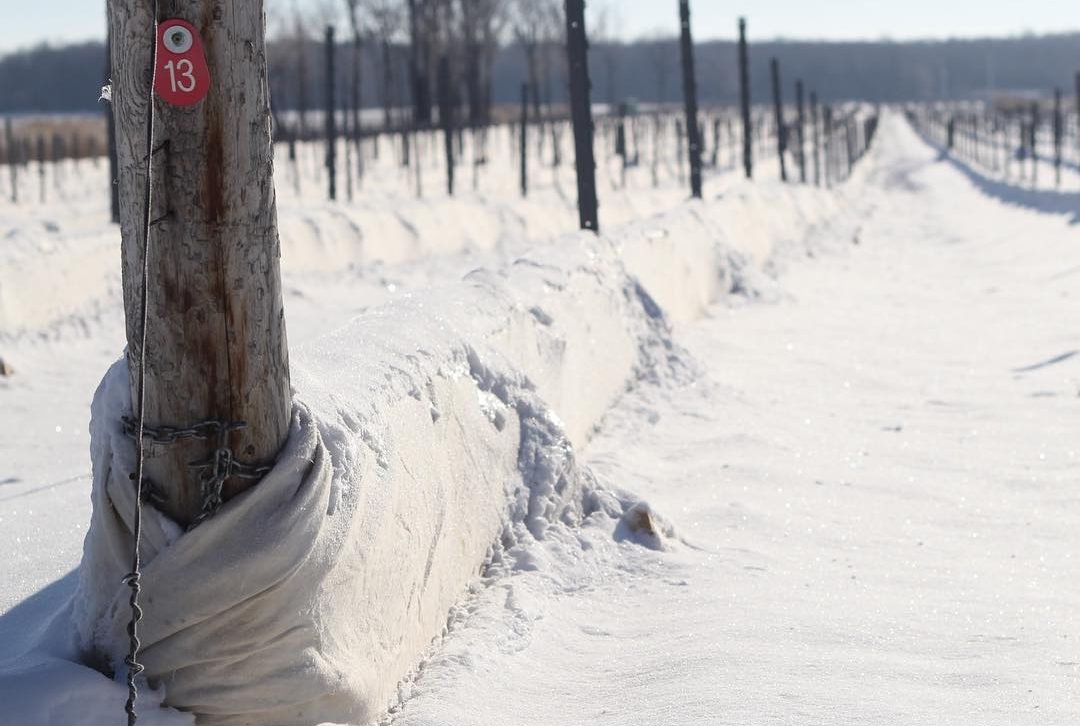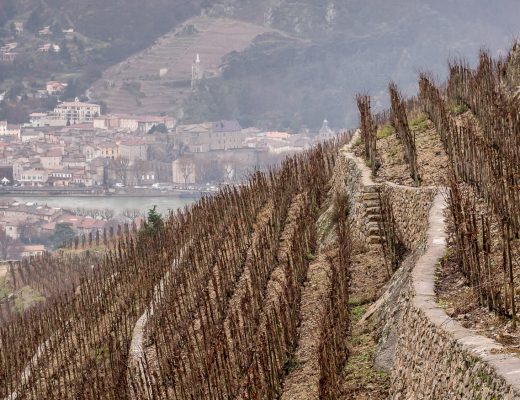Photo credit: Domaine St. Jacques
If you have spent any time chatting with wine geeks lately you may have heard them refer to certain wines as being “cool climate” in style. Perhaps you found yourself wondering, what are cool climate wines?
Vitis vinifera, the major grape vine species used to make wine, is a Mediterranean plant. It likes warm, sunny, fairly dry climates and produces abundant, ultra-ripe crops in these areas. In more marginal growing regions, the vine often struggles to fully ripen its grapes.
***Side note: I have also made this post into a YouTube video. To watch, just scroll down to the bottom & click play. If you enjoy the video, consider subscribing to my YouTube channel so you never miss an episode of my wine education series.
What is So Special about Cool Climate Wines?
It might seem counter-intuitive to grow a plant in a climate where the ripening of its crop is a constant concern. However, Vitis vinifera is a very particular species. The old adage goes that a grape vine needs to struggle to produce great wine. While not all winemakers would agree, many top producers do share this sentiment. Stressed vines generally produce lower grape yields which ripen at a slower rate. Proponents feel that this produces wines of greater concentration and complexity.
That is not to say that struggling vines always produce better quality. In the case of cool climates, grapes that have failed to fully ripen make thin, bitter, highly acidic wines that could strip the enamel from your teeth. However, grapes that have just attained that magical balance of vibrant acidity and sufficiently sweet fruit, with skins ripe enough to have lost their tough thickness and astringent taste, can produce incredibly elegant and refreshing wines.
Cool climate wines are generally lighter in body, with lower alcohol, and higher, more mouthwatering acidity than their counterparts from warmer growing regions. The fruit flavours are often subtler, ranging from tart to fresh, with green to white fruit notes on white wines and tangy cranberry, red berry and cherry aromas on reds.
In comparison, wines from warmer climates tend to be fuller-bodied, with higher alcohol, softer acidity, and more baked or jammy fruit flavours.
What Grapes Grow Best in Cool Climates?
Major concerns in cool climate growing areas include late budding, early autumn frosts, and cold winters. Grapes that ripen early and are able to withstand winter’s chill are best suited to cool climates.
In regions with frigid winters, where the thermostat regularly dips down below -20°C, cold-hardy hybrid grape varieties are often preferred by growers. Grapes like Frontenac, Maréchal Foch, Vidal and L’Acadie Blanc are popular in the coldest parts of Canada and northern USA.
Where winter conditions are slightly milder, Vitis vinifera varieties like Pinot Gris, Gewurztraminer, Riesling, Chardonnay, Gamay, Pinot Noir and Cabernet Franc thrive.
What Makes a Climate Cool?
According to acclaimed American wine writer Matt Kramer, “the notion of cool climate is, in many ways, a New World concept”. Kramer made this assertion during a webinar exploring the evolution of cool climate wines for this year’s virtual International Cool Climate Chardonnay Celebration (i4C).
Wines have been produced in marginal climates – like Chablis and Champagne – for centuries. However, classifying wines from these regions as “cool climate” is a relatively new phenomenon; one which has grown in prominence over the past ten years.
So, what factors make a wine region cool? To date there is no formal definition or set rules as to what constitutes a cool climate. With this in mind, a second i4C webinar, led by John Szabo MS, looked at major contributing factors to cool climates.
Latitudes between 30° and 50° in the northern and southern hemispheres are generally agreed to be the areas where wine grapes can successively be cultivated. Latitude has long been used as a primary argument for climate, with wine regions closer to 50° regularly typecast as cool climate.
Various measurement tools have also been developed in an attempt to codify viticultural climates. One system, called growing degree days (GDD) measures heat accumulation over the growing season. Another, called growing season temperature (GST), measures the average monthly temperature over the 7 months of the grape growing season. According to climate experts Gregory Jones and Hans Schultz, regions with GST averages between 13 – 15c, and GDDs of 850 – 1389 are classic cool climates regions.
However, climate classifications based solely on one-size-fits-all indicators like latitude or GDDs are increasingly being called into question. Each region has its own unique geography and weather patterns. Wind circulation, altitude, soil types and colours, proximity to bodies of water capable of tempering temperature extremes…these are just a handful of factors that can significantly affect a region’s temperatures and exposure to sunlight.
Where Can I Find Cool Climate Wines?
The lighter, fresher wine styles associated with cool climates are becoming increasingly popular with wine lovers. Wine regions proclaiming themselves cool are popping up all over the world, leading to growing critical skepticism.
That being said, most wine experts agree that vineyard areas like Champagne, the Loire Valley, and Burgundy produce cool climate wines. Well known cooler areas in the USA include much of Oregon, coastal areas of Sonoma, and parts of Santa Barbara County. In Australia, Tasmania is an exciting region for cool climate wines. In New Zealand, several areas make the cut, such as the Awatere Valley in Marlborough, and parts of Central Otago.
If you want to go slightly off the beaten track, England has a growing reputation for fine cool climate sparkling wines. Here are home, Nova Scotia and Québec are also great cool climate sparkling contenders. Ontario and British Columbia each possess a number of cool climate terroirs making a wide array of cool Chardonnay, Riesling, Gamay, Cabernet Franc and Pinot Noir wines.
Tasting Cool Climate Wines
The series of i4C lectures discussing and debating cool climate wines and regions culminated as all great wine conversations should, with a tasting. Here are my notes on the six wines from Chablis, New Zealand, and Ontario generously supplied to me by the regions to celebrate i4C and all things cool climate.
Domaine Laroche 2018 Petit Chablis, France
Excellent as an aperitif, this light-bodied, taut Petit Chablis offers discreet earthy, yellow apple and nettle notes on the nose. White grape fruit and lime flavours provide an attractive juiciness to the nervy, high acid. Finishes bone dry.
Where to Buy: SAQ (23.45$), inquire with agent in Ontario: Select Wines
Domaine Gueguen 1er Cru Vaucoupin 2018, Chablis, France
Very elegant premier cru Chablis, with pretty white blossoms and ripe orchard fruit notes on the nose. With a little time in the glass, underlying aromas of wet stone and white mushroom develop. The palate is defined by a firm, almost strident acidity on the attack that softens and broadens on the mid-palate. Vibrant white fruit flavours mingle with tingly saline notes that linger on the long, dry, finish.
Where to Buy: Inquire with agent Le Maitre de Chai
Villa Maria Single Vineyard Taylor’s Pass Chardonnay 2018, Marlborough, New Zealand
A really harmonious Chardonnay with bright yellow fruit aromas layered with buttered, flinty nuances and subtle toasty oak. The palate features vibrant acidity that enhances the juicy meyer lemon, passion fruit, and apricot flavours and balances the rich, round, textural palate. Pleasantly warming on the lengthy finish.
Where to Buy: LCBO (33.95$), inquire with agent in Québec: Vins Dandurand
Paddy Borthwick Chardonnay 2018, Wairarapa, New Zealand
Initially discreet nose, with an array of ripe, yellow fruit and flinty hints upon aeration. Fresh acidity provides definition to the rounded, full-bodied palate structure. Juicy stone fruits and subtle grapefruit pith bitterness on the dry, medium length finish. Slightly warming.
Where to Buy: LCBO (25.00$)
Leaning Post Senchuk Vineyard Chardonnay 2018, Lincoln Lakeshore VQA, Niagara, Ontario
Restrained earthy aromas on first approach, with delicate white floral, green apple, and lime hints developing after a few minutes in the glass. The racy acidity and very firm structure on this medium bodied white are balanced by a layered, textural mid-palate. Intriguing flavours of green fruits, earth and wet stone linger on the mouthwatering, dry finish. Needs 2 – 3 years cellaring to unwind.
Where to Buy: LCBO (45.00$, 2017 vintage), leaningpostwines.com
Legacy Willms Vineyard Chardonnay 2017, Four Mile Creek VQA, Niagara, Ontario
A highly aromatic style of Chardonnay (potentially Chardonnay Musqué?), brimming with white peach, Bartlett pear and vanilla notes on the nose and palate. Fresh, fruity, and rounded on the palate, with medium weight and a smooth finish. Best for lovers of soft, fruit-forward Chardonnay styles.
Where to Buy: adamoestate.com/shop/





No Comments